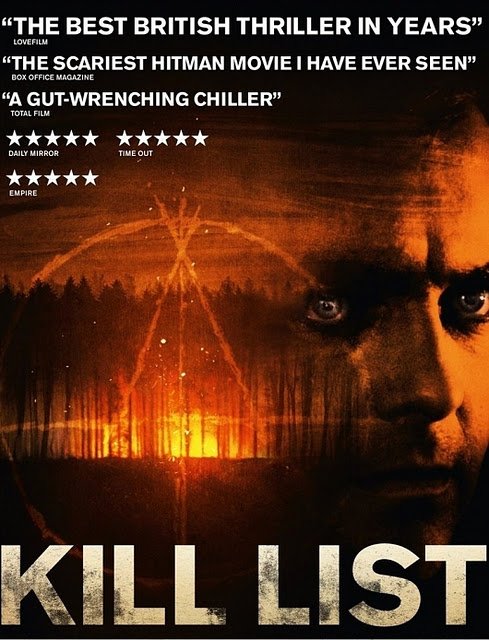Horror in the Home | Kill List’s Domestic Disharmony Fits Into the Horror Genre Mould
Halloween season is here, and to celebrate we’re publishing a series of blood-curdling horror-themed articles to satisfy our Film buffs. In this piece, Andrew Carroll discusses Kill List‘s domestic disharmony.

Horror is at its most effective when it turns previously safe spaces into places that are eerie, sinister and often deadly. Nowhere is safer than the home: you control who comes in and who goes out until something disrupts that control. The horror genre is full of houses that were thought to be ordinary but are actually hotbeds for ghostly activity. Apartment buildings that become mazes whose halls are stalked by mask wearing psychopaths. Idyllic country estates that, beneath their welcoming charm are havens for cults, strange monsters or inbred cannibal families. Nothing is more terrifying than the safety and comfort of one’s home life being turned upside down. Ben Wheatley mastered this horror genre trope in his 2011 film Kill List.
Kill List focuses on contract killer Jay (Neil Maskell) and his difficulty in making ends meet for his family. An old army comrade and fellow hitman Gal (Michael Smiley) makes Jay an offer he can’t refuse. The economy is in the depths of a recession and by killing three targets Jay will guarantee his family’s financial security. The plot is simple enough but even at the film’s beginning unusual events begin to occur that let the viewer know that this is no ordinary crime thriller nor is it an ordinary horror film.
Horror is often used as a metaphor whether it’s for mental illness, disease or domestic disorder. The current running through all of these themes is that something has invaded a previously safe and welcoming space. In The Exorcist an evil demon named Pazuzu invades the family home of Regan and Chris MacNeil. Teenagers enter a family homestead in The Texas Chainsaw Massacre and are summarily slaughtered for trespassing. John Carpenter’s film Halloween ran with the tagline “The night he came home…” Horror in the home is nothing new and Kill List takes this theme and runs with it in a number of subtle and altogether terrifying ways.
At the very beginning of Kill List the family cat kills a rabbit and rather than waste it Jay decides to cook and eat it. He waves at his wife Shel (MyAnna Burning) and son Sam (Harry Simpson) as he gleefully tucks in. This is the first of many unsettling moments that occur within and without of the family home but altogether suggest a deep undercurrent of tension and an uneasy home life. Gal offers Jay the contract at a dinner party hosted by Jay and Shel. A woman named Fiona is in attendance as Gal’s date as well. The dinner party is fraught with tension as Jay argues that he is still traumatised by a disastrous mission in Kiev some months ago that left him both mentally and physically scarred. Jay flies into a rage numerous times over the night before eventually accepting the contract. In the middle of all this Fiona slips away to the bathroom and carves a symbol on the back of the mirror. The symbol is eerily reminiscent of the twig talismans seen in The Blair Witch Project and only grows in significance as the film goes on. Here Kill List expands as a horror film as the eerie images of the first act begin to bleed into the broader scope of the second.

Contracts have a distinct place in horror films. Often they are involuntary such as the fatal promise of the videotape in The Ring. Some are willingly entered into by everyone except the victim as in Roman Polanski’s 1968 film Rosemary’s Baby. Others still are eagerly signed ala 2016’s The Witch. The contract of Kill List is undoubtedly the dark heart of the film as well as being one of the more specific tropes connecting Wheatley’s film to the genre. The contract both Jay and Gal sign is a blank sheet of paper that is signed by Jay and the client (Struan Rodger) in their own blood. Laurie Rose’s camerawork is anxious throughout the scene; a slight shake that then morphs into the shocked, juddering horror the viewer doubtlessly feels as Jay’s palm is sliced open. This is only the beginning of the waves of bloody violence that wash over Kill List as ceaselessly as the tide.
From the rabbit to the contract signing to the assassinations themselves Kill List and its characters are mired in brutal, gory violence from the get-go. Jay’s battle scars emphasise the violence that occurred in the past and that continues to influence the events of the film. There are three targets on the contract: a priest, a librarian and a politician. Ostensibly pillars of any sane community but nothing about Kill List feels sane or communal. Ben Wheatley uses violence as both a battering ram and a scalpel. The violence in the film is never clean, stylish or justified. Instead it is ugly, visceral and grotesque. It is only matched by a rare few films such as Bone Tomahawk, Martyrs and A Serbian Film none of which I would recommend to the faint of heart. The violence in the film is often committed by Jay and is a reflection of his own mental state and the crumbling world around him.
Kill List reaches its gory peak towards the end of its second act. Their first target, the priest, has been dealt with cleanly and efficiently. Their second target, the librarian, decidedly less so. Jay and Gal break into a storage unit and find shelves upon shelves of snuff films. The librarian is no meek, mild mannered public servant but instead an archivist of violent, pornographic films depicting death and dismemberment. Jay, triggered by what he sees, responds in kind. Taking a hammer, he tortures the librarian for information before smashing his head in like an egg on the man’s kitchen table. This sequence is notable not just for its brutal visual shocks but its disturbing audio effects as well. Disregarding the sound effects of a man being bludgeoned to death for a moment there is also the snuff film Jay watches but the viewer never sees. A drill whirs, a woman screams before the sound of the drill bit entering flesh cuts her off. Jay then laughs in horrified glee. Wheatley, who also co-edited the film with his wife Amy Jump, turns Kill List into an audio-visual gut punch on a par with Jennifer Kent’s The Babadook and Dario Argento’s Suspiria.
[youtube id=”aqkqF–v1tg” align=”center” autoplay=”no” maxwidth=”750"]
The film’s third act is a return to the home but Jay’s home has changed so much that he now barely recognises it. A cryptic prophet has replaced his doctor, the shadowy client threatens Jay and Gal’s families if they do not complete the contract and a sinister cult makes its presence known. Metamorphosis is one of horror’s most frightening and often stomach-churning facets. From the shape-shifting alien of The Thing to the face-swapping ghoul of It Follows and from The Wolfman to The Fly there have been many tales of grotesque physical and metaphorical changes through the decades. Metamorphosis in Kill List takes on a different form however. Jay returns from Kiev a changed man and is changed again by the sinister contract he is hired on. By the end of the film Jay is not the troubled man the viewer quickly empathised with instead he is detached from reality and those he cares about. For Jay to survive he must create a new home with a new family. To do that he must destroy the old one.
The ending of Kill List will leave viewers as breathless as the rest of the film will and so I will leave it unspoiled. Fans of Robin Hardy’s The Wicker Man (not the Nicolas Cage one) will be pleasantly surprised at the faithfulness of Wheatley’s references. Horror aims to leave those that consume it shocked, terrified and shaken to their core. Good horror does that well but great horror leaves its viewers with talking points. Kill List and all of the other great films I’ve namedropped here are examples of great horror. Though Kill List takes its influence from a great deal of horror films it is definitively its own film.
Ben Wheatley is an auteur filmmaker in his own right and the originality of his
crime-thriller-psychological-cult-horror opus reflects this. It is a thought-provoking film that covers themes such as mental illness, moral depravity and economic turmoil. Just like any great horror it will keep the post-cinema conversation between you and your friends going all the way until you split off from each other and all of a sudden you’re alone. All alone except for that unshakeable feeling that something or someone is right behind you…

